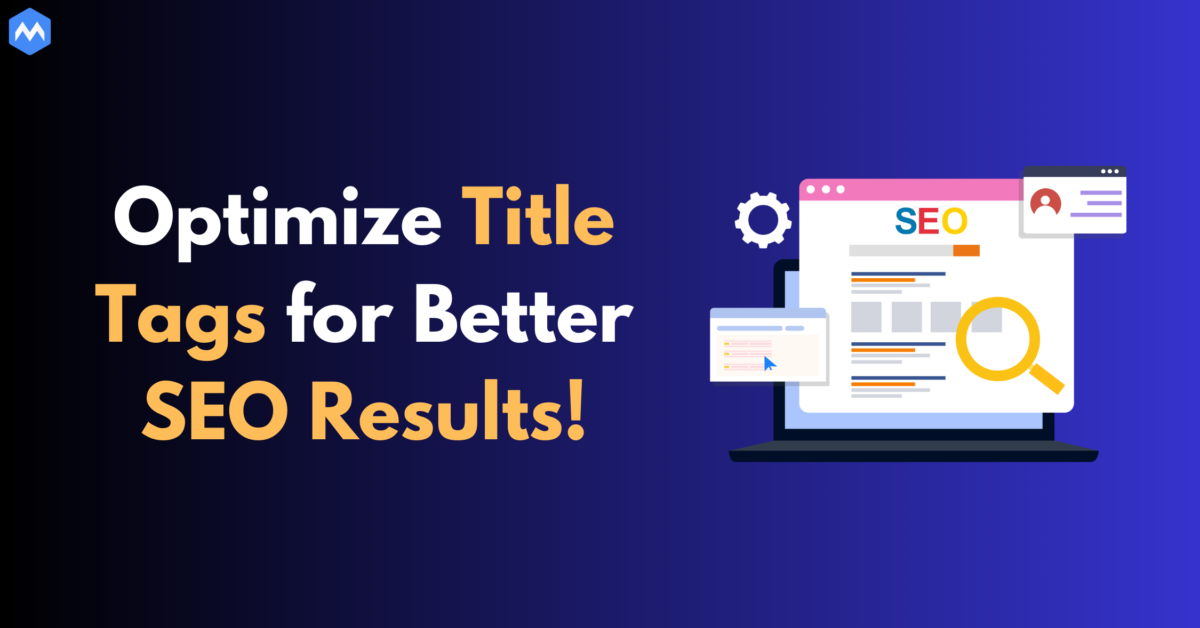Title Tag Optimization: Your Key to Optimization Search Engine Success
The manner your website seems on seek engine effects pages (SERPs) is decided by way of its title tag optimization. It’s a small but substantial ranking component which you shouldn’t brush aside in addition to luring the person to click on on the web page. Using the best title strategies can maximize engagement and search visibility, enhancing the likelihood of a click-through. It is simply certainly one of many on-web page SEO factors we focus on whilst optimizing pages and content. The title tag’s content material, which appears because the blue link in the seek effects furnished by the SERPs, plays a essential role in searchers’ decisions to click on through to our website. In this text, we can learn about the significance of title tags. We’ll cover the best practices you should follow to optimize your tags effectively, make every word count, common mistakes to avoid, and more.
What is a title tag in SEO?
Every webpage’s head section contains an HTML tag called the HTML title tag, which provides an overall summary or background of the page’s topic.
The HTML title tag is prominently featured on search engine results pages (SERPs) as a clickable link and also appears in the browser window, making it essential for user navigation and SEO.
Why Are Title Tags Important?
Let’s explore the 4 principal motives that name tags are important, in particular in search engine optimization:
Title Tags Can Affect Your SEO Rankings
It can affect your SEO rankings (i.e., unpaid visibility in search engine results). Because they help search engines, such as Google, determine the topic of your page and how pertinent it is to each user’s inquiry.
Title Tags Can Appear in Search Results
Title tags are frequently used by Google as title links. These are the search engine results page (SERP) titles that can be clicked.
Your click-through rate, or the number of clicks you receive, can be greatly influenced by the title link.
Title Tags Can Appear in Link Previews
Links on social media platforms, instant messaging apps, etc. may have it displayed in their previews.
Users may be less inclined to click through if the title is absent or not optimised well.
Title Tags Appear in Browser Tabs
Title tags instruct a browser on how to show the tabular title of a page. When a user has numerous tabs open, this helps them go to the correct page.
Title tag SEO best practices
Analyze the SERPs
To determine the meaning behind your chosen core keyword, you must examine the search engine results. Four different categories of search intent include
- Informational
- Navigational
- Commercial
- Transactional
By reflecting the search intent in the title, content may be created specifically for a certain keyword. Ensure unique titles, not copying verbatim ones.
Tag one primary keyword
Your title tag should focus on one main keyword. That keyword will be already known to you because you will find it throughout your pre-writing keyword research.
A page’s rankings may suffer if its title contains an excessive number of keywords. Considering that it is spam.
Users may become confused as a result and be less inclined to click through to your page.
Include important words first.
A web page’s title tag should be compelling at the first glance, so you need to be aware of phrase order. The goal is to let the user see the most important words first, as doing so decreases the chances they’ll scroll past your page.
User can find the page they’re looking for in their browser tabs more easily as a result. Then read through your SERP result.
Optimize title tag length
When considering how many tags in HTML are crucial for SEO, the title tag stands out as essential. An optimized title tag should be between 50–60 characters, including spaces, to ensure it appears fully on the search engine results page. Since there’s limited space, include only the most important words and phrases without filler. If your title tag exceeds this length, it will be cut off, reducing its effectiveness—so keep it descriptive yet concise.
Visit Here: Mastering On-Page SEO Techniques: A Comprehensive Guide
Title tag optimization tools
Title tag optimization is a critical aspect of SEO, and several tools can help streamline the process and maximize effectiveness. Here are some notable tools specifically designed for title tag optimization:
- SEMrush:SEMrush is a complete search engine marketing tool that offers a extensive range of capabilities, which includes competitor research, on-page optimisation, and keyword research. You can track rankings, examine your title tags, and find areas for boom with SEMrush.
- Ahrefs: Another powerful search engine marketing tool is Ahrefs, which provides statistics on web site audits, backlink evaluation, and keyword research. With its Site Explorer function, you could examine meta descriptions, title tags, and different on-page elements to optimise for search exposure.
- Moz Pro: A variety of SEO tools are available from Moz Pro, such as rank tracking, site audits, and keyword research. With Moz Pro, you can perform on-page optimization, including title tag optimization for better search engine performance.
- Google Search Console: Google Search Console is a free tool provided with the aid of Google to assist internet site owners screen and hold their website online’s rank within Google Search results. It gives you information on impressions, click through rates, and search queries, so that you can compare how properly your title tags are doing and alter as essential.
- Yoast SEO:One famous WordPress plugin that enables with search engine optimisation is Yoast SEO. To help improve title tags, meta descriptions, and other on-web page features and increase search exposure, it offers real-time tips and remarks.
These tools can help you analyze, optimize, and track the performance of your title tags to improve your website’s search engine visibility and drive better results in organic search.
How long should a title tag be?
Although most desktop and mobile browsers can display a title tag’s first 50–60 characters, Google does not advocate a certain length for title tags. Ninety percent of your titles should show up correctly on the search engine results page if your title tag has fewer than 60 characters. This SEO title length ensures that the title tag displays properly on search engine results pages (SERPs) without being truncated.
Common title tag mistakes
Some of the common mistakes you can make when writing title tags are:
Missing <title> Element
If you don’t specify a title tag in your HTML code, you don’t have a title. Google will make up a title based on the page’s content in search results.
Repetitive or Boilerplate Titles
Title tags inform a user what kind of page they’re clicking on. You’ll produce a bad experience if you try to employ a certain template or if you just keep using the same terms.
Keyword Stuffing
Keyword stuffing is the process of unnaturally forcing keywords into content, to rank higher.
Think like a user when writing titles. Focus on accurately and concisely describing your page with not more than two keywords.
Long Title Design
When creating a Long Title, it’s important to consider the potential for Google to shorten or rewrite it if it exceeds 70 characters. To avoid this, aim to keep your Long Title under 60 characters. This ensures that it displays properly on both mobile and desktop devices without getting cut off, improving visibility and click-through rates.
Non-Descriptive Text
When a person searches, Google tries its best to deliver results that align with their search intent. Therefore, Google will most likely change the title of your home page to something more precise if you choose a vague option like “Home Page.”
How to write title tag in SEO
Before you start this process, you should know what your target keyword is. If not, research potential keywords. Otherwise, let’s get started.
Step 1: Check to find out if the right SEO tag keyword is being targeted.
Your goal keyword should be included in your SEO tag, as title tags still serve as a minor ranking influence. However, it’s essential to confirm that you’re targeting the right keyword before moving forward. The Parent Topic, for those unfamiliar, is the keyword that drives the most traffic to the top-ranking page for your chosen keyword. Targeting this keyword can often maximize your page’s traffic potential.
Step 2: Find potential ‘secondary’ keywords to add
Different people search for things in different ways. When appropriate, incorporate well-known terms into your title to address this.
Look for the keywords driving the most traffic to the page with the highest rating to identify these terms.
Step 3: Make your title more clickable (ABC formula)
There’s no one-size-fits-all method for creating an enticing title tag, but the ABC formula is a good place to start. Choose these elements carefully; the current top-ranking results can provide valuable information about what searchers care about. More clicks translate to more traffic, so creating a compelling title optimization is crucial.
Conclusion
A title might seem like a small piece of the SEO puzzle but don’t underestimate its impact. Make sure your title appropriately describes your page because it can have a significant impact on both your organic traffic and SERP rank.
Following the guidelines in this guide will help you create engaging title tags that drive clicks in addition to helping your website rank well. Always keep the searcher and your audience in mind. Find the right balance between incorporating important keywords while also matching the intent of the topic. Metaloop Marketing provides the best SEO Services Agency. SEO marketing requires a significant investment of time and knowledge to develop a competitive strategy for the digital marketplace.



Write a Comment